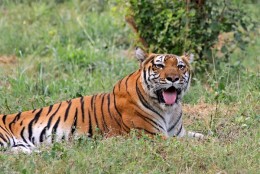 The Kaziranga National Park is a UNESCO world heritage site, located in the the heart of Assam, on the southern bank of the Brahmaputra River. This park is in a remote area of North East India where the impact of man has been negligible.
The Kaziranga National Park is a UNESCO world heritage site, located in the the heart of Assam, on the southern bank of the Brahmaputra River. This park is in a remote area of North East India where the impact of man has been negligible.
Kaziranga has been a great conservation success story and is home to two thirds of the world population of one-horned rhinoceros, as well as many mammals, including tigers, elephants, panthers and bears.
The density of tigers here is one of the highest in India but they can be difficult to spot in the long grass and thick forest.
The riverine habitat consists primarily of tall, dense grasslands, interspersed with open forests, interconnecting streams and numerous small lakes. Three-quarters or more of the area is submerged annually by the flood waters of the Brahmaputra.
The vegetation comprises seasonally inundated grasslands, tropical wet evergreen forests and tropical semi-evergreen forests.
Activities in Kaziranga National Park
Game viewing is by 4×4 safari jeeps and is also possible on elephant back.
Species Found in Kaziranga National Park
One-horned Indian rhino, Indian elephant, Bengal tiger, water buffalo, gaur (Indian bison), leopard, jungle cat, leopard cat, fishing cat, civet, wild boar, sloth bear, Bengal fox, golden jackal, pangolin, sambar, chital, barasingha, muntjac and nine primate species including the rare hoolock gibbon. In 2012 a extremely rare black panther was spotted in the reserve. Kaziranga is also an excellent birding destination and home to some huge reticulated and rock pythons and the largest venomous snake in the world, the king cobra.
Best Time to Visit Kaziranga National Park
The park is open from 1st November to 30th April. Optimum time to visit is mid-November to early April
Chance of seeing a tiger – fair
Location – Assam
Tours Visiting Kaziranga
The Big Four
Wild Assam Cruise
